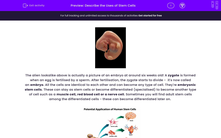
The alien lookalike above is actually a picture of an embryo at around six weeks old! A zygote is formed when an egg is fertilised by a sperm. After fertilisation, the zygote starts to divide - it's now called an embryo. All the cells are identical to each other and can become any type of cell. They're embryonic stem cells. These can stay as stem cells or become differentiated (specialised) to become another type of cell such as a muscle cell, red blood cell or a nerve cell. Sometimes you will find adult stem cells among the differentiated cells - these can become differentiated later on.

The function of stem cells
Specialised cells produce specific proteins because the genes coding for these proteins are activated or switched on. Embryonic stem cells are able to differentiate into any cell type. This is because any of the genes in their chromosomes are able to be switched on.
Stem cells are important for many reasons. In the embryo, stem cells will develop into the whole body of the organism, including all of the organs such as the heart, lungs, skin and other tissues and cells. In some adult tissues, such as bone marrow, adult stem cells are used to replace damaged blood cells and can be used to treat conditions such as leukaemia.
Uses of stem cells
The fact that stem cells can undergo cell division and become differentiated to become any cell type, makes stem cells really interesting to scientists. It opens the way for potential new treatments to replace cells lost to injury and disease, and research may help to develop alternatives to organ transplant, as well as to enable the testing of the effects of new drugs.
Cancers such as leukaemia, which affects white blood cells, can be treated using stem cells. Bone marrow transplant involves destroying damaged or diseased blood cells and replacing them with healthy adult stem cells from the bone marrow.
Most medical uses of stem cells are still experimental. Treatments are still being researched for treating diseases such as:
Heart disease - by using the patient’s own stem cells from bone marrow to replace damaged cells in the heart.
Type 1 diabetes - by using stem cells to replace damaged cells in the pancreas to produce insulin.
Risks
The properties of stem cells are not fully understood. This means that there are some risks involved in stem cell treatment:
There's a risk of infections from the operations involved, or from infected stem cells.
There's a risk that tumours may form due to uncontrolled cell division.
There's a risk that it could cause damage to organs - stem cells implanted into damaged tissue might move to healthy areas and cause damage to those areas.
There's also a risk that the person's own immune system will reject the stem cells from another person, and that their white blood cells will destroy them.
Ethical issues
There are different types of issues depending on the type of cells involved. Often, with embryonic stem cells, the issue of using embryos can be a sensitive topic. Some people's religious or personal beliefs view the embryo as representing life and that it should only be used to create a baby. In science, obtaining a balanced view is important and often there is no one correct answer.
In the following activity, you will describe stem cells and some of their uses in medicine.








